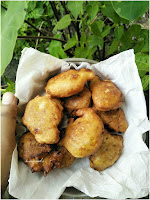Banana malpua is an Indian style banana pancake . It is very easy to prepare. I normally use leftover ripe bananas to make banana malpua. Banana malpua is soft and fluffy which can be served with tea special with the evening cup of tea.
Banana Malpua
📎Cuisine : Indian
🔪Preparation Time : 10 minutes
♨Cooking Time : 15 minutes
🕞Total : 25 minutes
INGREDIENTS:
- 1 cup maida or all purpose flour
- 1 cup milk or as required
- 2-3 tbsp sugar (I am using less amount of sugar)
- 1/2 tsp baking powder (optional)
- 2 ripe bananas
- 2-3 cups of cooking oil or as required
METHOD:
- Peel the bananas and then mashed it properly.
- In a bowl take all purpose flour. Add sugar.
- Add milk and mix thoroughly.
- Add mashed ripe bananas and mix properly with the liquid. Use food processor if required.
- Now the batter is ready.
- Heat oil in a pan.
- With the help of a large spoon, put one full spoon of batter into the hot oil. Cook, flip and fry until both sides turn golden brown. Drain and keep aside. Repeat with remaining batter.
- Serve hot with tea.

Delicious
ReplyDelete